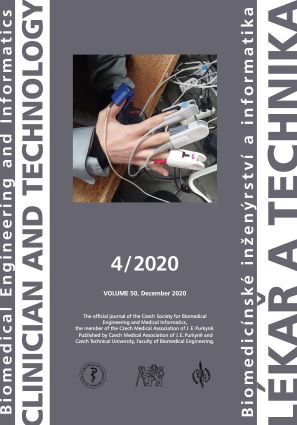THE USE OF PACEMAKER DIAGNOSTICS FOR SUPPORTING THE ANTICOAGULATION TREATMENT MANAGEMENT
DOI:
https://doi.org/10.14311/CTJ.2020.4.04Abstract
In this work, the analysis of data on atrial fibrillation (AF) burden from dual chamber pacemakers is used for supporting the anticoagulation treatment management. The aim is to evaluate the benefit of basic diagnostic functions to support oral anticoagulation therapy in patients with atrial fibrillation. These patients have increased risk of thromboembolism. If patients have an implanted pacemaker, the device’s diagnostic features monitor the frequency and duration of atrial fibrillation episodes. This data can then be used for further decisions. Statistical data processing was performed on a group of 117 patients with an implanted dual chamber pacemaker. From these results, we evaluated the benefits of the algorithms. In the whole group, a trend was observed in increase of the AF burden between the two monitored periods. The increase of AF burden occurred in 17 patients, while the decrease occurred in 6 patients only. Using simple logic functions, the numbers of patients with different binary values of the presence of AF, the presence of oral anticoagulation therapy, the risk CHA2DS2-VASc score and the values of AF burden were determined. Thus, in the whole group of patients, the diagnostic functions of the implanted devices contributed to the change in oral anticoagulation therapy for 24% of patients.
Downloads
Published
Issue
Section
License
Copyright (c) 2021 David Korpas, Michaela Tanzerová

This work is licensed under a Creative Commons Attribution 4.0 International License.
Authors who publish with this journal agree to the following terms:
- Authors retain copyright and grant the journal right of the first publication with the work simultaneously licensed under a Creative Commons Attribution License (https://creativecommons.org/licenses/by/4.0/) that allows others to share the work with an acknowledgment of the work's authorship and initial publication in CTJ.
- Authors are able to enter into separate, additional contractual arrangements for the non-exclusive distribution of the journal’s published version of the work (e.g., post it to an institutional repository or publish it in a book), with an acknowledgment of its initial publication in this journal.
- Authors are permitted and encouraged to post their work online (e.g., in institutional repositories or on their website or ResearchGate) prior to and during the submission process, as it can lead to productive exchanges.
CTJ requires that all of the content of the manuscript has been created by its respective authors or that permission to use a copyrighted material has been obtained by the authors before submitting the manuscript to CTJ. CTJ requires that authors have not used any copyrighted material illegally, as for example a picture from another journal or book, a photo, etc. It is the author’s responsibility to use only materials not violating the copyright law. When in doubt, CTJ may ask the authors to supply the pertinent permission or agreement about the use of a copyrighted material.
The opinions expressed in CTJ articles are those of authors and do not necessarily reflect the views of the publishers or the Czech Society for Biomedical Engineering and Medical Informatics.


